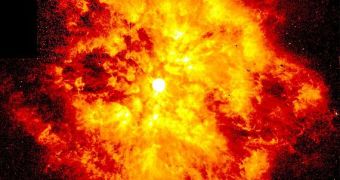Some years ago, the explosion of Type 1 supernovas led astronomers and astrophysicists to inferring that dark energy existed. Since then, analyzing these massive celestial events has been the only way of predicting the properties and traits of the mysterious form of energy. Due to the fact that the relative distance between Earth and the supernovas could only be assessed with a 10 percent degree of uncertainty, all models on dark energy could only be devised with a substantial degree of error-proneness built in. Now, through a collaboration between the Yale University, the Lawrence Berkeley National Laboratory (LBNL), as well as a group of French institutes, researchers can better estimate the distances at which Type 1 supernovas are burning.
When massive stars explode to form supernovas, the light they emit burns with such intensity that it becomes visible from Earth even if the star died billions of light years away. However, the intensity of the light is roughly the same, astronomers say, and so the relative distance between Earth and the object can be measures based on the dimness or brightness of the incoming visible, radio or X-ray radiation. But, while the supernovas have the same type of light, the stars they were formed from do not have the exact same chemical composition. This means that subtle variations in their luminosity makes it extremely difficult for observers to pinpoint their exact position.
As part of the massive-scale survey Nearby Supernovae Factory, researchers began using the Yale-built QUEST optical camera (the largest in the world) to look for these formations. Over the years, they discovered about 185 nearby supernovas, of which 58 were included in the new international research. By using an observatory in Hawaii, the team was able to infer the light signature of each of the analyzed remnants, and to determine how each of them glowed as opposed to the others. This helped them develop new calculations, which they believe will in the future help researchers pinpoint supernovas Type 1 with only 6 percent uncertainty.
“Measuring the distance to supernovae has been a major problem in astronomy ever since the discovery of dark energy. To understand how dark energy behaved in the early universe, we needed to make more precise measurements,” said the YU Eugene Higgins Professor of Physics, Charles Baltay, one of the authors of a new study detailing the finds, which will be published in a forthcoming issue of the journal Astronomy & Astrophysics. “The excitement of science is not knowing what you’re going to find. But it’s nice that this first set of supernovae has already proved useful,” he added.
There are critics to the new study, though. Some have pertinently brought up the fact that the research takes the existence of dark energy for granted, whereas no evidence of it existing has been made available anywhere in the world at this point. That is to say, the concept exists, but it was not discovered, but created, so that astronomers and astrophysicists could answer a series of questions that would have otherwise remained a mystery, PhysOrg reports.

 14 DAY TRIAL //
14 DAY TRIAL //